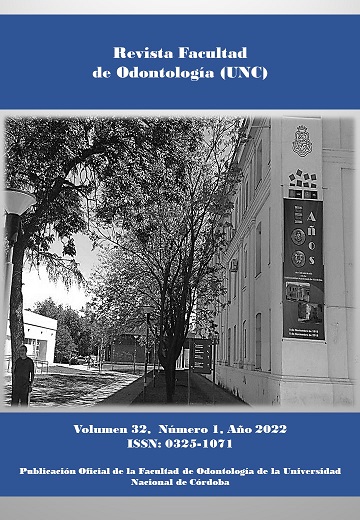Tatuaje por amalgama: Caso Clínico
Palavras-chave:
Amalgama dental, tatuaje, argentum metallicum, trastornos de la pigmentación, Macula.Resumo
El tatuaje de amalgama o argirosis focal, es una lesión iatrogénica que sigue a la implantación traumática de partículas de amalgama en tejido blando o a la transferencia pasiva por fricción crónica de la mucosa contra una restauración de amalgama se caracteriza por el depósito de restos de material restaurativo compuesto por una mezcla de plata, mercurio, zinc, estaño y cobre en el tejido conectivo. Objetivo presentar el caso clínico de un paciente con tatuaje por amalgama y el tratamiento que fue realizado previo a su rehabilitación dental. Métodos Se realizó diagnóstico y la biopsia excisional de la lesión pigmentada Resultado como resultado de la biopsia encontramos tatuaje por amalgama con reacción granulomatosa a cuerpo extraño. Conclusión: Por medio de una Biopsia excisional se comprobó el diagnóstico de la lesión que se observó en la paciente, resultando así un tatuaje por amalgama con reacción granulomatosa a cuerpo extraño
Referências
1. Albuquerque DMdS, Cunha JLS, Roza ALOC, Arboleda LPA, Santos- Silva AR, Lopes MA, et al. Oral pigmented lesions: a retrospective analysis from Brazil. Med Oral Patol Oral Cir Bucal. 2021;26(3):e284-91.
2. Rosebush MS, Briody AN, Cordell KG. Black and Brown: Non-neoplastic Pigmentation of the Oral Mucosa. Head Neck Pathol. 2019;13(1):47-55.
3. Regezi JA, Sciubba JJ, Jordan RCK, Oral Pathology: Clinical Pathologic Correlations, 7th ed. China: Elsevier, 2017.
4. Neville BW, Damm DD, Allen CM, Chi AC, Oral and Maxillofacial Pathology, 4th ed. Canada: Elsevier, 2016.
5. Arjona-Aguilera C, Collantes-Rodríguez C, Gil-Jassogne C, Ossorio-García L, Jiménez-Gallo D. Pigmented oral lesion in a patient with metastatic melanoma. Indian J Dermatol Venereol Leprol. 2018 ;84(1):117-119.
6. Parizi J. Nai G. Amalgam tattoo: a cause of sinusitis?. Journal of Applied Oral Science. 2010;18(1):100-104.
7. GojkovVukelic M, Hadzic S, Pasic E. Laser Treatment of Oral Mucosa Tattoo. Acta Inform Med. 2011;19(4):244-246.
8. Gondak RO, da Silva-Jorge R, Jorge J, Lopes MA, Vargas PA. Oral pigmented lesions: Clinicopathologic features and review of the literature. Med Oral Patol Oral Cir Bucal. 2012;17(6):e919-24.
9. Lundin K, Schmidt G, Bonde C. Amalgam tattoo mimicking mucosal melanoma: a diagnostic dilemma revisited. Case Rep Dent. 2013;2013:787294.
10. Forsell M, Larsson B, Ljungqvist A, Carlmark B, Johansson O. Mercury content in amalgam tattoos of humanoral mucosa and its relation to local tissue reactions. Eur J Oral Sci. 1998;106(1):582-587.
11. Anusavice KJ. Philips ́ Science of Dental Materials: Elsevier 11th ed. Canada: Elsevier, 2003.
12. Vázquez ASJ, Sandoval SE, Chung R, García PMP, Cornejo VJA. Identification of Mercury Levels on the Operator’s FaceMask During the Removal Of Dental Amalgamas: Pilot Study. Adv Dent & Oral Health. 2017;3(3):55613.
13. Laimer J, Henn R, Helten T, Sprung S, Zelger B, Zelger B, Steiner R, Schnabl D, Offermanns V, Bruckmoser E, Huck CW. Amalgam tattoo versus melanocytic neoplasm - Differential diagnosis of dark pigmented oral mucosa lesions using infrared spectroscopy. PLoS One. 2018;13(11):e0207026.
14. Natarajan E. Black and Brown Oro-facial Mucocutaneous Neoplasms. Head Neck Pathol. 2019;13(1):56-70.
15. Yélamos O, Cordova M, Peterson G, Pulitzer MP, Singh B, Rajadhyaksha M, DeFazio JL. In vivo intraoral reflectance confocal microscopy of an amalgam tattoo. Dermatol Pract Concept. 2017;7(4):13-16.
Publicado
Edição
Seção
Licença

Este trabalho está licenciado sob uma licença Creative Commons Attribution-NonCommercial-ShareAlike 4.0 International License.
Aquellos autores/as que tengan publicaciones con esta revista, aceptan los términos siguientes:
- Los autores/as conservarán sus derechos de autor y garantizarán a la revista el derecho de primera publicación de su obra, el cuál estará simultáneamente sujeto a la Licencia de reconocimiento de Creative Commons que permite a terceros:
- Compartir — copiar y redistribuir el material en cualquier medio o formato
- La licenciante no puede revocar estas libertades en tanto usted siga los términos de la licencia
- Los autores/as podrán adoptar otros acuerdos de licencia no exclusiva de distribución de la versión de la obra publicada (p. ej.: depositarla en un archivo telemático institucional o publicarla en un volumen monográfico) siempre que se indique la publicación inicial en esta revista.
- Se permite y recomienda a los autores/as difundir su obra a través de Internet (p. ej.: en archivos telemáticos institucionales o en su página web) después del su publicación en la revista, lo cual puede producir intercambios interesantes y aumentar las citas de la obra publicada. (Véase El efecto del acceso abierto).

